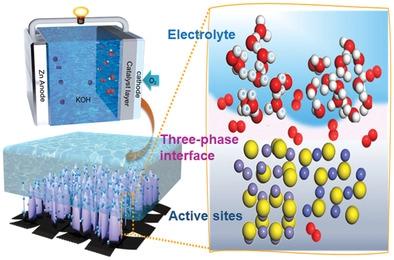当前位置:
X-MOL 学术
›
Adv. Energy Mater.
›
论文详情
Our official English website, www.x-mol.net, welcomes your
feedback! (Note: you will need to create a separate account there.)
Engineering Self-Supported Hydrophobic–Aerophilic Air Cathode with CoS/Fe3S4 Nanoparticles Embedded in S, N Co-Doped Carbon Plate Arrays for Long-Life Rechargeable Zn–Air Batteries
Advanced Energy Materials ( IF 24.4 ) Pub Date : 2023-01-25 , DOI: 10.1002/aenm.202204245 Lei Yan 1 , Binbin Xie 2 , Chen Yang 3 , Yahao Wang 3 , Jiqiang Ning 4 , Yijun Zhong 3 , Yong Hu 2, 3
Advanced Energy Materials ( IF 24.4 ) Pub Date : 2023-01-25 , DOI: 10.1002/aenm.202204245 Lei Yan 1 , Binbin Xie 2 , Chen Yang 3 , Yahao Wang 3 , Jiqiang Ning 4 , Yijun Zhong 3 , Yong Hu 2, 3
Affiliation

|
The highly sluggish kinetics of oxygen reduction/evolution reactions (ORR/OER) at air cathodes lead to problems such as low power density and unsatisfactory cycling life with rechargeable Zn–air batteries (RZABs). To engineer the reaction kinetics at the air cathodes, a hydrophobic–aerophilic strategy is developed to fabricate a self-supported air cathode based on CoS/Fe3S4 nanoparticles encapsulated in S, N co-doped carbon plate arrays (CoS/Fe3S4@SNCP). It is experimentally shown that the in situ growth of bimetallic sulfides nanoparticles on the carbon plate arrays improves the intrinsic electrocatalytic activity and electron conduction of the air cathode. Meanwhile, the ab initio molecular dynamics simulations reveal that the hydrophobic–aerophilic surface can repel water molecules to create abundant solid–liquid–gas three-phase reaction interfaces as well as to expose Fe-sites, which consequently promote the diffusion of reactive molecules/ions across the interface and the oxygen adsorption. As a result, the CoS/Fe3S4@SNCP electrode exhibits excellent OER and ORR activities with a smaller potential gap of 0.65 V. For the engineered hydrophobicity of the catalyst, the RZAB demonstrates a high power density of 272 mW cm−2, a narrow discharge/charge gap of 0.75 V at 10 mA cm−2, and long-term cycling stability over 1400 h, outperforming its hydrophilic CoS@SNCP counterparts.
中文翻译:

将 CoS/Fe3S4 纳米颗粒嵌入 S、N 共掺杂碳板阵列中的工程自支撑疏水-亲气空气阴极,用于长寿命可充电锌-空气电池
空气阴极的氧气还原/析出反应 (ORR/OER) 的动力学非常缓慢,导致可充电锌空气电池 (RZAB) 的功率密度低和循环寿命不理想等问题。 为了设计空气阴极的反应动力学,开发了一种疏水-亲气策略来制造基于封装在 S、N 共掺杂碳板阵列中的CoS/Fe 3 S 4纳米颗粒的自支撑空气阴极(CoS/Fe 3小号4@SNCP)。实验表明,双金属硫化物纳米粒子在碳板阵列上的原位生长提高了空气阴极的本征电催化活性和电子传导。同时,从头算分子动力学模拟表明,疏水-亲气表面可以排斥水分子,形成丰富的固-液-气三相反应界面,并暴露铁位点,从而促进反应分子的扩散/界面上的离子和氧气的吸附。因此,CoS/Fe 3 S 4 @SNCP 电极表现出优异的 OER 和 ORR 活性,具有更小的 0.65 V 电位差。对于催化剂的工程疏水性,RZAB 表现出 272 mW cm 的高功率密度-2 ,在 10 mA cm -2时的 0.75 V 窄放电/充电间隙,以及超过 1400 小时的长期循环稳定性,优于其亲水性 CoS@SNCP 对应物。
更新日期:2023-01-25
中文翻译:

将 CoS/Fe3S4 纳米颗粒嵌入 S、N 共掺杂碳板阵列中的工程自支撑疏水-亲气空气阴极,用于长寿命可充电锌-空气电池
空气阴极的氧气还原/析出反应 (ORR/OER) 的动力学非常缓慢,导致可充电锌空气电池 (RZAB) 的功率密度低和循环寿命不理想等问题。 为了设计空气阴极的反应动力学,开发了一种疏水-亲气策略来制造基于封装在 S、N 共掺杂碳板阵列中的CoS/Fe 3 S 4纳米颗粒的自支撑空气阴极(CoS/Fe 3小号4@SNCP)。实验表明,双金属硫化物纳米粒子在碳板阵列上的原位生长提高了空气阴极的本征电催化活性和电子传导。同时,从头算分子动力学模拟表明,疏水-亲气表面可以排斥水分子,形成丰富的固-液-气三相反应界面,并暴露铁位点,从而促进反应分子的扩散/界面上的离子和氧气的吸附。因此,CoS/Fe 3 S 4 @SNCP 电极表现出优异的 OER 和 ORR 活性,具有更小的 0.65 V 电位差。对于催化剂的工程疏水性,RZAB 表现出 272 mW cm 的高功率密度-2 ,在 10 mA cm -2时的 0.75 V 窄放电/充电间隙,以及超过 1400 小时的长期循环稳定性,优于其亲水性 CoS@SNCP 对应物。













































 京公网安备 11010802027423号
京公网安备 11010802027423号